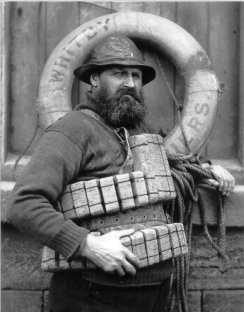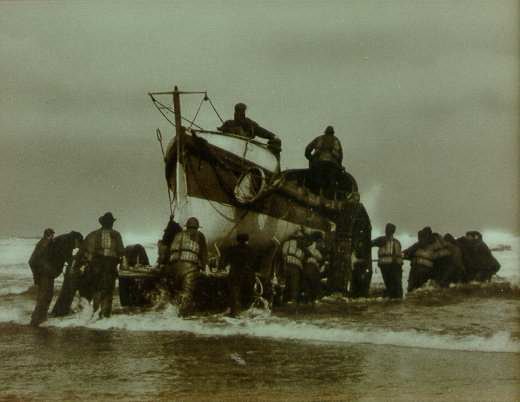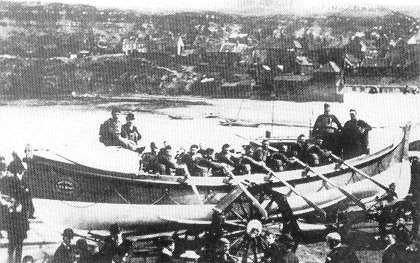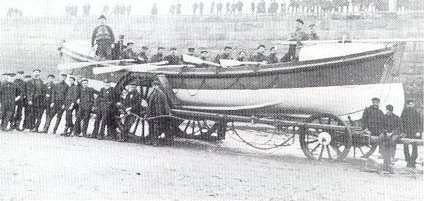In October 1914 the hospital ship Rohilla, sailing
from Queensfary, bound for Dunkirk, with a full medical staff and five
nurses, a total of 229 people, onboard, ran aground in worsening weather off
Saltwick nab. In these conditions the Whitby number one boat couldn't be
launched.
So they lifted the number two boat, which was kept afloat in winter,
out of the water, over an eight foot wall, then put it on skids and dragged
it along the beach to a position opposite the Rohilla. Despite being holed
twice and the heavy surf, they launched the lifeboat John Fielden.
And after a struggle they reached the ship that was lying 450 yards
off shore, surrounded by jagged rocks, they rescued the 5 nurses and 12 of
the men and landed them on the beach.
Returning to the ship they rescued a further 18 men. On returning to
shore the lifeboat sustained further damage and she was too badly damaged to
be used again.
The Upgang lifeboat, another Whitby boat, was brought from her
boathouse and lowered down the vertical cliffs onto the beach, calls went
out to Teesmouth and Scarborough lifeboat stations asking for assistance,
the Scarborough boat arrived at 6 p.m.
By this time it was dark and it was impossible to get near the ship,
so they waited a few hundred yards from the shore all night hoping to get a
chance to go alongside the ship.
The Scarborough lifeboat, after spending 18 hours at sea in appalling
conditions, and the men suffering badly, were forced to return home, towed
by the steam trawler Morning Star.
The Teesmouth lifeboat stationed 22 miles north of Whitby was a 42
foot self-righting boat that had been converted to a motor lifeboat. As she
was leaving the harbour at Teesmouth she ran into mountainous seas and
sprung a leak. A tug had to tow the damaged lifeboat back to Middlesborough.
The next day the number one lifeboat, the Robert and Mary Ellis, was
launched into the harbour and set out to sea, coxswain Langlands in charge,
to await the arrival of the steam trawler Mayfly from Hartlepool, which
towed the lifeboat to within half a mile of the Rohilla.
After a discussion between Langlands and James Hastings, the second
coxswain of the Hartlepool lifeboat that was on the Mayfly, it was decide
the lifeboat should return to Whitby harbour. At 9 o'clock the Upgang
lifeboat was launched, but after struggling for over an hour, the crew
totally exhausted, returned to shore.
It became apparent only a motor lifeboat could attempt a rescue of
the remaining people on the wreck. A telegram was sent to Tynemouth
for the motor lifeboat Henry Vernon, a 40 foot self-righter. Within 15
minutes the boat was underway, they reached Whitby at 1 p.m. on Sunday.
Taking a quantity of oil with them to flatten the sea, they set out
for the wreck. Heavy seas were still crashing over the Rohilla 3 days after
she ran aground. Two hundred yards from the wreck the lifeboat men poured
the oil onto the sea to flatten the waves. The effect was dramatic, the
heavy breakers flattening out to a heavy swell. Coxswain Smith took the
Henry Vernon in at full speed.
Within seconds the crew of the Rohilla lowered ropes and ladders and
40 men were taken on board the lifeboat. Two enormous waves engulfed the
lifeboat, she shook off the water and the last ten men were taken on board,
the rescue was completed in 15 minutes.
The danger was far from being over. The effects of the oil were
wearing off, the lifeboat, as she was leaving the stern of the Rohilla, was
hit broadside by an enormous herself and she was brought safely into Whitby
harbour along with the remaining 50 men, who were taken to waiting
ambulances then to the hospital. Of the 229 people on board the Rohilla, 84
perished.
The damaged lifeboat, the John Fielden, was broken in two on the
rocks by the high tide. A relief lifeboat was sent to Whitby No 2 station.
She was the Forestar reserve No 4 boat, a self-righter built in 1900
for the No 2 station at Tynemouth. She was soon in action saving the crew of
16 from the SS Ingrid 2 after she ran aground on Whitby rocks. This boat
served Whitby for less than five years, and saved a total of 98
lives.








